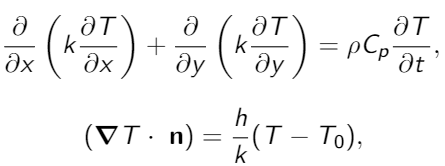For updating, I'm pretty sure the error is about the hard constraints BC since the PDE does not satisfy the dirichletBC even I put lots of weight in there. How can I set the Dirichlet BC for this case? For example, T(x, y=0) = 1. I read the Q&A. However, these problems are about, i.e., y(0) = 0, not 1. Thank you, Lu Lu, again for the amazing library.

Dear @lululxvi, Thank you for the great and useful library that can help a beginner like me approaching the PINNs techniques. Recently, I start investigating a heat transfer problem that consists of 2 convective boundary conditions (RobinBC) and 1 Dirichlet BC. Here is the domain The PDE and RobinBC are shown, respectively, as
The PDE and RobinBC are shown, respectively, as

First, to test the algorithm, I use only one convection BC (Robin one) one the upper edge CD. The result shows a good prediction with the temperature increases linearly from the bottom to the upper. This really makes sense. However, when I do the real problem with 2 convective BC (the right and upper edges), the results look extremely off as shown below, which the bottom edge seems not to hold the temperature during the simulation even I use Dirichlet in there.
Here is the code for implementing the algorithm
The training and testing are not converged well even I use the loss_weights option. I read all of the Q&A to get some ideas however the problem still existed. One more notice that I tried to use the model to predict the material point in the bottom edges only and see that they are not always equal to the reference value as the Dirichlet should do. Do you think the hard constraints BC will work in this problem?. Is it the right expression for the DirichletBC hard constraints in my case?
net.apply_output_transform(lambda x, T: x[:, 1:2] * T + T_ABOnce again, thank you so much for the useful library DeepXDE. Do you have any suggestions that I can try out?
Thank you very much.